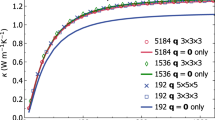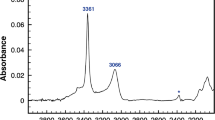Abstract
Simple model calculations show that the reversible temperature effects reported for broad OH-stretching bands in infrared spectra of silica, aluminosilicate, and similar glasses can be explained, in essentials, by homogeneous thermal broadening of the ν(OH) envelope constituents and a decrease in intensity with increasing temperature taking place uniformly across the band. This means that these effects are reasonably consistent with the temperature behaviour of narrow ν(OH) bands of crystalline OH-bearing minerals. These findings leave little room for the previously agreed interpretation in terms of a change in hydrogen-bonding strength, although the dependence of integrated intensity on temperature still remains to be understood.
Similar content being viewed by others
Author information
Authors and Affiliations
Additional information
Received: 16 April 1999 / Accepted: 4 April 2000
Rights and permissions
About this article
Cite this article
Zarubin, D. Modelling the OH stretch envelope shape and temperature effects in infrared spectra of hydrous silica and silicate glasses. Phys Chem Min 27, 590–597 (2000). https://doi.org/10.1007/s002690000099
Issue Date:
DOI: https://doi.org/10.1007/s002690000099




